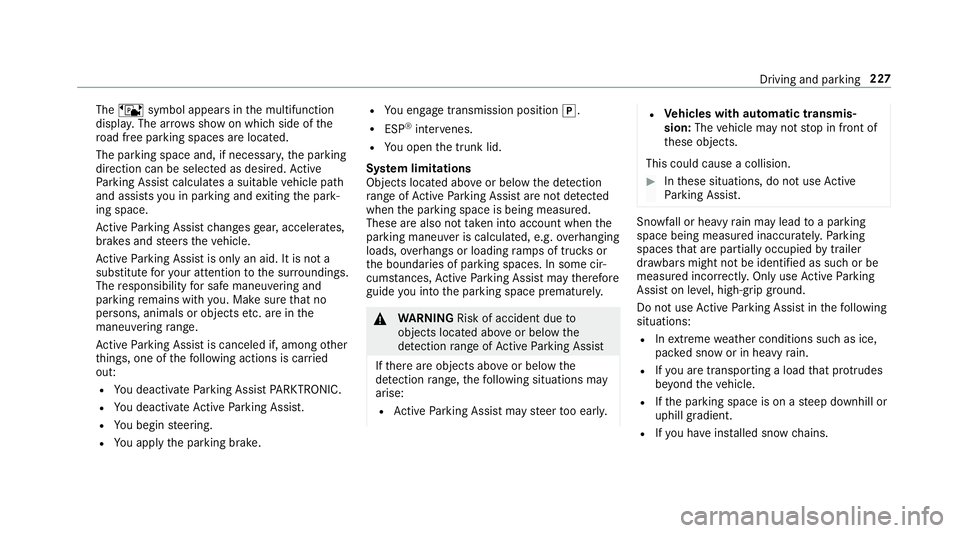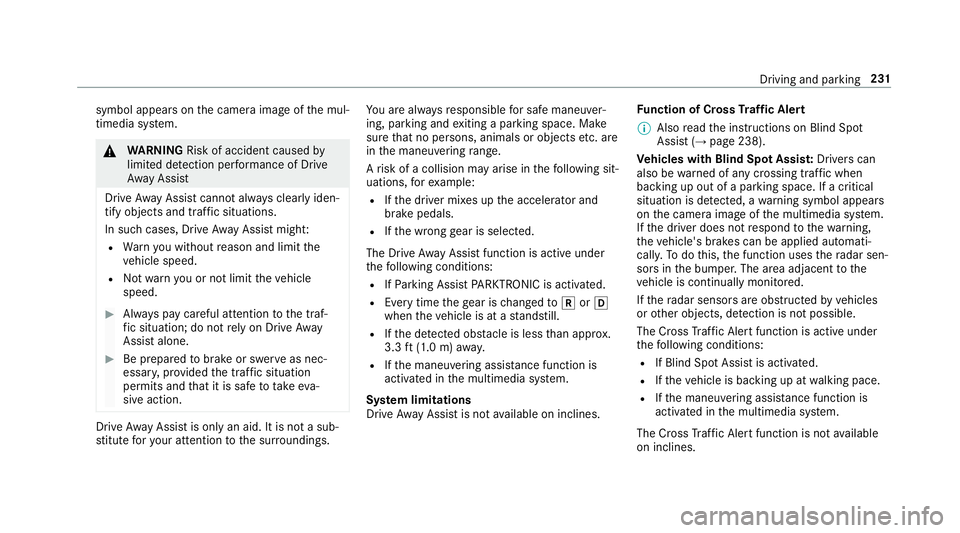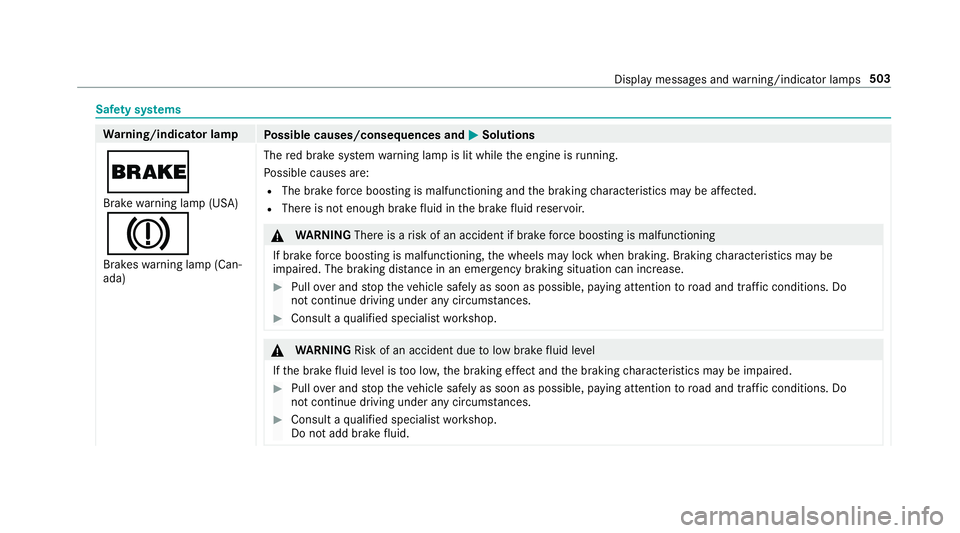2018 MERCEDES-BENZ S-CLASS SEDAN brakes
[x] Cancel search: brakesPage 229 of 562

Theë symbol appears in the multifunction
displa y.The ar rowsshow on which side of the
ro ad free parking spaces are located.
The parking space and, if necessar y,the parking
direction can be selected as desired. Active
Pa rking Assist calculates a suitable vehicle path
and assists youin parking and exiting the park‐
ing space.
Ac tive Parking Assist changes gear, accelerates,
brakes and steers theve hicle.
Ac tive Parking Assist is only an aid. It is not a
substitute foryo ur attention tothe sur roundings.
The responsibility for safe maneu vering and
pa rking remains with you. Make sure that no
persons, animals or objects etc. are in the
maneu vering range.
Ac tive Parking Assist is canceled if, among other
th ings, one of thefo llowing actions is car ried
out:
RYo u deactivate Parking Assist PARKTRONIC.
RYou deactivate Active Parking Assist.
RYo u begin steering.
RYo uappl yth e parking brake.
RYo u enga getransmission position j.
RESP®intervenes.
RYo u open the trunk lid.
Sy stem limitations
Objects located abo veor below the de tection
ra nge of Active Parking Assist are not de tected
when the parking space is being measured.
These are also no t
ta ke n i
nto account when the
parking maneuver is calculated, e.g. overhanging
loads, overhangs or loading ramp s of truc ksor
th e boundaries of parking spaces. In some cir‐
cums tances, Active Parking Assist may therefore
guide you into the parking space prematurel y.
&
WARNING Risk of accident due to
objects located abo veor below the
de tection range of Active Parking Assist
If th ere are objects abo veor below the
de tection range, thefo llowing situations may
arise:
RAc tive Parking Assist may steer too early.
RVe hicles with automatic transmis‐
sion: Thevehicle may not stop in front of
th ese objects.
This could cause a collision.
#In these situations, do not use Active
Pa rking Assist.
Sn owfa ll or heavy rain may lead toa parking
space being measured inaccuratel y.Pa rking
spaces that are partial lyoccupied bytrailer
dr aw bars might not be identified as such or be
measured incor rectly. Only use Active Parking
Assist on le vel, high-grip ground.
Do no t useActive Parking Assist in thefo llowing
situations:
RIn extreme weather conditions such as ice,
pac ked snow or in heavy rain.
RIfyo u are transporting a load that pr otru des
be yond theve hicle.
RIfth e parking space is on a steep downhill or
uphill gradient.
RIf yo u ha veinstalled snow chains.
Driving and parking 227
Page 233 of 562

symbol appearsonthe camera image of the mul‐
timedia sy stem.
&
WARNING Risk of accident caused by
limited de tection per form ance of Drive
Aw ayAssist
Drive AwayAssist cannot al ways clearly iden‐
tify objects and traf fic situations.
In such cases, Drive AwayAssist might:
RWarnyouwit hout reason and limit the
ve hicle speed.
RNot warnyou or not limittheve hicle
speed.
#Alw ays pay careful attention tothe traf‐
fi c situation; do not rely on Driv eAw ay
Assist alone.
#Be prepared tobrake or swer veas nec‐
essar y,prov ided the tra ffic situation
permits and that it is safe totake eva‐
sive action.
Drive AwayAssist is only an aid. It is not a sub‐
st itute foryo ur attention tothe sur roundings. Yo
u are alw aysre sponsible for safe maneu ver‐
ing, parking and exiting a parking space. Make
sure that no persons, animals or objects etc. are
in the maneuvering range.
A risk of a collision may arise in thefo llowing sit‐
uations, forex ample:
RIfth e driver mixes up the accelera tor and
brake pedals.
RIf th e wrong gear is selecte d.
The Drive AwayAssist function is active under
th efo llowing conditions:
RIf Pa rking Assist PARKTRONI Cis activated.
REver ytime thege ar is changed tok orh
when theve hicle is at a standstill.
RIf th e de tected obs tacle is less than appr ox.
3.3 ft(1.0 m) away.
RIfth e maneuvering assis tance function is
acti vated in the multimedia sy stem.
Sy stem limitations
Drive AwayAssist is notavailable on inclines. Fu
nction of Cross Traf fic Alert
% Also read the instructions on Blind Spot
Assist (
→page 238).
Ve hicles with Blind Spot Assis t:Dr ivers can
also be warned of any crossing traf fic when
back ing up out of a parking space. If a critical
situation is de tected, a warning symbol appears
on the camera image of the multimedia sy stem.
If th e driver does n
ot respond tothewa rning,
th eve hicle's brakes can be applied automati‐
cally. Todo this, the function uses thera dar sen‐
sors in the bumper. The area adjacent tothe
ve hicle is continually monitored.
If th era dar sensors are obstructed byvehicles
or other objects, de tection is not possible.
The Cross Traf fic Alert function is acti veunder
th efo llowing conditions:
RIf Blind Spot Assist is activated.
RIf th eve hicle is backing up at walking pace.
RIfth e maneuvering assis tance function is
acti vated in the multimedia sy stem.
The Cross Traf fic Alert function is not available
on inclines.
Driving and parking 231
Page 434 of 562

these are ins talled on theve hicle, but does not
include passengers or luggage.
Maximum tire load: the maximum tire load is
th e maximum permissible weight in kilog rams or
lbs for which a tire is appr oved.
Maximum permissible tire pressure: maxi‐
mum permissible tire pressure for one tire.
Maximum load on one tire: maximum load on
one tire. This is calculated bydividing the maxi‐
mum axle load of one axle bytwo.
PSI (pounds per square in ch):standard unit of
measurement for tire pressure .
Aspect ratio: ratio between tire height and tire
width in pe rcent.
Ti re pressure: pressure inside the tire applying
an outward forc eto eve rysquare inch of the tire.
The tire pressure is specified in pounds per
square inch (psi), in kilopascals (kPa) or in bar.
The tire pressure should only be cor rected when
th e tires are cold.
Cold tire pressure: the tires are cold when the
ve hicle has been par kedfo r at least 3 hours without direct sunlight on
the tires or theve hicle
has been driven for less than 1 mile (1.6 km).
Ti re contact sur face: the part of the tire that
comes into con tact wi th thero ad.
Ti re bead: the purpose of the tire bead is to
ensure that the tire sits securely on the wheel
ri m. There are se veral wire cores in the tire bead
to pr
eve ntthe t
ire fromchanging length on the
wheel rim.
Side wall:the part of the tire between the tread
and the tire bead.
We ight of optional equipment: the combined
we ight of the optional equipment weighing more
th an there placed standard parts and more than
5 lbs (2.3 kg).This optional equipment, such as
high-per form ance brakes, le vel control sy stem, a
ro of luggage rack or high-per form ance batte ries,
is not included in the curb weight and thewe ight
of the accessories.
TIN (Tire Identification Number): a unique
identification number which can be used bya
tire manufactu rerto identify tires, forex ample,
in a product recall, and thus identify the pur‐
ch asers. The TIN is made up of the manufactur‐ er's identity code, tire size, tire type code and
th
e manufacturing date.
Load-bearing index: the load-bearing index is a
code that con tains the maximum load-bearing
capacity of a tire.
Tr action: traction is the grip resulting from fric‐
tion between the tires and thero ad sur face.
We ar indicator: narrow bars (tread wear bars)
th at are distributed overth e tire conta ct surface.
If th e tire tread is le vel with the bars, thewe ar
limit of 1/ 16in (1.6 mm) has been reached.
Distribution of vehicle occupants: distribution
of vehicle occupants ov
er design
ated seat posi‐
tions in a vehicle.
Maximum permissible pa yload weight: nomi‐
nal load and luggage load plus 150 lb (68 kg)
multiplied bythe number of seats in theve hicle.
432
Wheels and tires
Page 435 of 562

Changing a wheel
Notes on selecting, mounting and replacing
tires
Mercedes -AMG vehicles: be sure toobser ve
th e no tes in the Supplement. Otherwise, you
may not recognize dangers.
Yo u can ask for information rega rding permitte d
wheel/tire combinations at an authorized
Mercedes-Benz Center.
& WARNING Risk of accident due toincor‐
re ct dimensions of wheels and tires
If wheels and tires of the wrong size are
ins talled, the wheel brakes or wheel suspen‐
sion components may be damaged.
#Alw aysre place wheels and tires with
th ose that fulfill the specifications of
th e original part.
When replacing wheels, make sure tofit th e
cor rect:
RDesignation
RModel
When replacing tires, make sure toins tallth e
cor rect:
RDesignation
RManufactu rer
RModel
&
WARNING Risk of injury thro ugh exceed‐
ing the specified tire load rating or the
permissible speed rating
Exceeding the specified tire load rating or
th e permissible speed rating may lead totire
damage andtothe tires bur sting.
#Therefore, only use tire types and sizes
appr ovedfo ryo ur vehicle model.
#Obser vethe tire load rating and speed
ra ting requ ired foryo ur vehicle.
* NO
TEDama getovehicle and tires due to
non-app rove d tire types and sizes
Fo r saf etyre asons, only use wheels, tires
and accessories which ha vebeen appr oved
fo ryo ur vehicle byMercedes-Benz.
These tires ha vebeen specially adap tedfo r
use with the control sy stems, e.g. ABS or
ESP
®, and are mar ked as follo ws :
RMO = Mercedes-Benz Original
RMOE = Mercedes-Benz Original Extended
(run-flat tires only for cer tain wheels)
RMO1 = Mercedes-Benz Original (only cer‐
tain AMG tires)
Cer tain characteristics, e.g. handling, vehicle
noise emissions or fuel consum ption, may
ot herwise be adversely af fected. In addition,
when driving wi tha load, tire dimension var‐
iations could cause the tires tocome into
contact wi th the body and axle components.
This could result in damage tothe tires or the
ve hicle.
Wheels and tires 433
Page 437 of 562

Observethefo llowing when selecting, mounting
and replacing tires:
ROnly use tires and wheels of the same type
(summer tires, winter tires, MOEx tended
tires) and the same make.
ROnly mount wheels of the same size on one
axle (left and right).
It is only permissible toins tall a dif fere nt
wheel size in theeve nt of a flat tire in order
to drive tothe specialist workshop.
ROnly mount tires of the cor rect size onto the
wheels.
RVe hicles with a tire pressure monitoring
sy stem: All mounte d wheels must be equip‐
ped with functioning sensors forth e tire
pressure monitoring sy stem.
RAt temp eratures below 45 °F (7 °C), use win‐
te r tires or all-season tire mar ked M+S for all
wheels.
Wi nter tires bearing thei snowflake sym‐
bol in addition tothe M+S marking pr ovide
th e best possible grip in wintry road condi‐
tions.
RFo r M+S tires, only use tires with the same
tread.
RObser vethe maximum permissible speed for
th e M+S tire mounted.
If th is is below theve hicle's maximum speed,
th is must be indicated in an appropriate label
in the driver's field of vision.
RBreak in new tires at moderate speeds for
th efirs t 60 miles (100 km).
RRe place the tires af ter six years at the latest,
re ga rdless of wear.
RWhen replacing with tires that do n otfea‐
ture run-flat characteristics: vehicles with
MOExtended tires are not equipped with a
TIREFIT kit at thefa ctor y.Equip theve hicle
with a TIREFIT kit af terre placing with tires
th at do not feature run-flat characteristics,
e.g. winter tires.
Fo r more information on wheels and tires, con‐
ta ct a qualified specialist workshop.
Be sure toalso observ eth efo llowing fur ther
re lated subjects:
RNo tes on tire pressure (→page 414)
RTire and Loading Info rmation placard
(→page 420)
RTi re size designation, load-beari ng capacity,
speed rating and load ind ex(→page 428)
RTire pressure table (→page 416)
Note s on inter changing wheels
&
WARNING Risk of injury thro ugh dif fer‐
ent wheel sizes
Inter changing the front and rear wheels if the
wheels or tires ha vediffere nt dimensions
may se verely impair the driving characteris‐
tics.
The wheel brakes or wheel suspension com‐
ponents may also be damaged.
#Ro tate front and rear wheels only ifth e
wheels and tires are of the same dimen‐
sions.
Wheels and tires 435
Page 453 of 562

Notes on brake fluid
Obser vethe no tes on operating fluids
(→page 447).
&
WARNING Risk of an accident due to
va por poc kets form ing in the brake sys‐
te m
The brake fluid cons tantly absorbs moist ure
from the air. This lo wersthe boiling point of
th e brake fluid. If the boiling point is too lo w,
va por poc kets may form inthe brake sy stem
when the brakes are applied hard.
This causes the braking ef fect to be
impaired.
#Ha ve the brake fluid rene we d at the
specified inter vals.
Ha ve the brake fluid regularly changed at a quali‐
fi ed specialist workshop.
Only use brake fluid appr ovedby Mercedes-Benz
according toMB-F reigabe or MB-Appr oval 33 1.0. Fu
rther information on brake fluid:
RIn the Mercedes-Benz Specifications for
Operating Fluids at http://be vo.mercedes-
benz.com
RAt aqu alified specialist workshop
Coolant
Note s on coolant
Obser vethe no tes on operating fluids
(
→page 447).
&
WARNING ‑ Risk of fire and injury from
antifreeze
If antifreeze comes into contact with hot
component parts in the engine compart‐
ment, it may ignite.
#Allow the engine tocool down before
adding antifreeze.
#Make surethat no antifreeze spills out
next tothefiller opening.
#Thoroughly clean off any antifreeze
from component parts before starting
th eve hicle.
* NO
TEDama gecaused byincor rect cool‐
ant
#Only add coolant that has been pre‐
mixed with therequ ired antifreeze pro‐
te ction.
Fu rther information on coolant:
RIn the Mercedes-Benz Specifications for
Operating Fluids 310.1, e.g. online at
http://be vo.mercedes-benz.com.
RAt aqu alified specialist workshop.
* NO
TEOverheating at high outside tem‐
peratures
If an inappro priate coolant is used, the
engine cooling sy stem is not suf ficiently pro‐
te cted against overheating and cor rosion at
high outside temp eratures.
Tech nical da ta451
Page 504 of 562

Instrument Display intheWi descreen Co ck‐
pit
Prog ressive setting (Widescreen Cockpit)
Ifyo u select the progressive display setting in
ve hicles with a Widescreen Cockpit, the position
of the indicator lamps in the Instrument Display
ch anges.
Wa rning and indicator lamps:
L Low beam (
→page
143)
T Pa
rking lights (
→page 143)
K High beam
(
→page14 4)
#! Tu
rn signal light (
→page 144)
R Re
ar fog light (
→page 143)
ü Seat belt is not
fastened
(
→page 510)
$ US
A: brakes (red) (
→page 503)
J Canada: brakes (red) (
→page 503)
! ABS malfunction (
→page 503)
÷ ESP
®(→page 503)
å ESP
®OFF (→page 503)
F USA: electric parking brake applied
(red) (
→page 503) !
Canada: electric parking brake
applied (red) (
→page 503)
! Electric parking brake (yellow
)
(
→page 503)
Ð St
eering assis tance malfunction
(
→pa ge 512)
# Electrical malfunction (
→page
513)
6 Re
stra int sy stem (
→page 503)
; Check Engine (
→page
513)
8 Fu
elreser vewith fuel filler cap loca‐
tion indicator (
→page 513)
? Coolan
tto o hot/cold (
→page 513)
· Dis
tance warning (
→page 511)
h Ti
re pressure monitoring sy stem
(
→page 517)
50 2
Displ aymessage s andwarning/indicator lamps
Page 505 of 562

Safety sy stems
Wa rning/indicator lamp
Possible causes/consequences and MSolutions
$
Brakewarning lamp (USA)
J
Brakes warning lamp (Can‐
ada) The
red brake sy stem warning lamp is lit while the engine is running.
Po ssible causes are:
RThe brake forc e boosting is malfunctioning and the braking characteristics may be af fected.
RThere is not enough brake fluid inthe brake fluid reser voir.
&
WARNING Thereis arisk of an accident if brake forc e boosting is malfunctioning
If brake forc e boosting is malfunctioning, the wheels may lock when braking. Braking characteristics may be
impaired. The braking dis tance in an eme rgency braking situation can increase.
#Pull over and stop theve hicle safely as soon as possible, paying attention toroad and traf fic conditions. Do
not continue driving under any circums tances.
#Consult a qualified specialist workshop.
&
WARNING Risk of an accident due tolow brake fluid le vel
If th e brake fluid leve l is too lo w,the braking ef fect and the braking characteristics may be impaired.
#Pull over and stop theve hicle safely as soon as possible, paying attention toroad and traf fic conditions. Do
not continue driving under any circums tances.
#Consult a qualified specialist workshop.
Do not add brake fluid.
Display messages and warning/indicator lamps 503